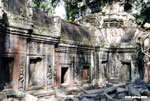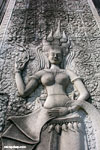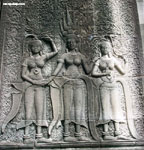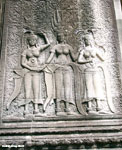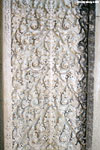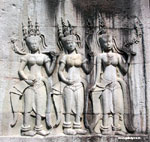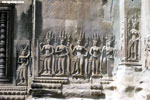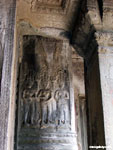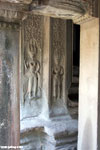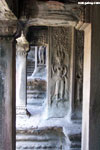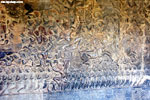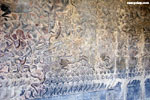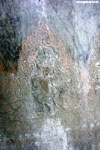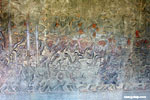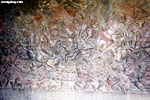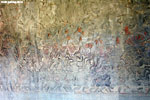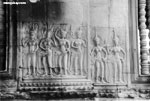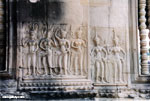Cambodia Pictures
Angkor Wat
All images are the property of Rhett Butler, copyright 2003.
Contact me regarding use and reproduction.
Angkor of Cambodia was the heart of the Khmer Empire for about 550 years (9th to 15th centuries) before overpopulation and environmental degradation lead to its abandonment. At its peak, the city spawled over an area the size of Los Angeles and supported more than a million people.
There are three pages of Angkor Wat images: Angkor Wat, Halls & Doors, and Figurines & Murals
Recommended travel guides on Cambodia:

Dark ages of Cambodia - from Wikipedia
The more than four centuries that passed from the abandonment of Angkor around the mid-15th century to the establishment of a protectorate under the French in 1863 are considered by historians to be Cambodia's "dark ages," a period of economic, social, and cultural stagnation when the kingdom's internal affairs came increasingly under the control of its aggressive neighbors, the Thai and the Vietnamese. By the mid-19th century, Cambodia had become an almost helpless pawn in the power struggles between Thailand and Vietnam and probably would have been completely absorbed by one or the other if France had not intervened, giving Cambodia a colonially dominated "lease on life." Fear of racial and cultural extinction has persisted as a major theme in modern Cambodian thought and helps to explain the intense nationalism and xenophobia of the Khmer Rouge during the 1970s. Establishment in 1979 of the People's Republic of Kampuchea, a Vietnamese-dominated satellite state, can be seen as the culmination of a process of Vietnamese encroachment that was already well under way by the seventeenth century.
The process of internal decay and foreign encroachment was gradual rather than precipitous and was hardly evident in the fifteenth century when the Khmer were still powerful. Following the fall of Angkor Thom, the Cambodian court abandoned the region north of the Tonle Sap, never to return except for a brief interlude in the late sixteenth century. By this time however, the Khmer penchant for monument building had ceased. Older faiths such as Mahayana Buddhism and the Hindu cult of the god-king had been supplanted by Theravada Buddhism, and the Cambodians had become part of the same religious and cultural cosmos as the Thai. This similarity did not prevent intermittent warfare between the two kingdoms, however. During the sixteenth century Cambodian armies, taking advantage of Thai troubles with the Burmese, invaded the Thai kingdom several times.
In the meantime, following the abandonment of the Angkorian sites, the Khmer established a new capital several hundred kilometers to the southeast on the site of what is now Phnom Penh. This new center of power was located at the confluence of the Mekong and the Tonle Sab rivers. Thus, it controlled the river commerce of the Khmer heartland and the Laotian kingdoms and had access, by way of the Mekong Delta, to the international trade routes that linked the China coast, the South China Sea, and the Indian Ocean. A new kind of state and society emerged, more open to the outside world and more dependent on commerce as a source of wealth than its inland predecessor. The growth of maritime trade with China during the Ming dynasty (1368-1644) provided lucrative opportunities for members of the Cambodian elite who controlled royal trading monopolies. The appearance of Europeans in the region in the sixteenth century also stimulated commerce.
King Ang Chan (1516-66), one of the few great Khmer monarchs of the post-Angkorian period, moved the capital from Phnom Penh to Lovek. Portuguese and Spanish travelers who visited the city, located on the banks of the Tonle Sab, a river north of Phnom Penh, described it as a place of fabulous wealth. The products traded there included precious stones, metals, silk and cotton, incense, ivory, lacquer, livestock (including elephants), and rhinoceros horn (prized by the Chinese as a rare and potent medicine). By the late sixteenth and early seventeenth centuries, Lovek contained flourishing foreign trading communities of Chinese, Indonesians, Malays, Japanese, Arabs, Spanish, and Portuguese. They were joined later in the century by the English and the Dutch.
Because the representatives of practically all these nationalities were pirates, adventurers, or traders, this was an era of stormy cosmopolitanism. Hard-pressed by the Thai, King Sattha (1576-94) surrounded himself with a personal guard of Spanish and Portuguese mercenaries, and in 1593 asked the Spanish governor of the Philippines for aid. Attracted by the prospects of establishing a Spanish protectorate in Cambodia and of converting the monarch to Christianity, the governor sent a force of 120 men, but Lovek had already fallen to the Thai when they arrived the following year. The Spanish took advantage of the extremely confused situation to place one of Sattha's sons on the throne in 1597. Hopes of making the country a Spanish dependency were dashed, however, when the Spaniards were massacred two years later by an equally belligerent contingent of Malay mercenaries.
The Thai, however, had dealt a fatal blow to Cambodian independence by capturing Lovek in 1594. With the posting of a Thai military governor in the city, a degree of foreign political control was established over the kingdom for the first time. Cambodian chronicles describe the fall of Lovek as a catastrophe from which the nation never fully recovered.
Domination by Thailand and by Vietnam
More than their conquest of Angkor a century and a half earlier, the Thai capture of Lovek marked the beginning of a decline in Cambodia's fortunes. One possible reason for the decline was the labor drain imposed by the Thai conquerors as they marched thousands of Khmer peasants, skilled artisans, scholars, and members of the Buddhist clergy back to their capital of Ayutthaya. This practice, common in the history of Southeast Asia, crippled Cambodia's ability to recover a semblance of its former greatness. A new Khmer capital was established at Odongk (Udong), south of Lovek, but its monarchs could survive only by entering into what amounted to vassal relationships with the Thai and with the Vietnamese. In common parlance, Thailand became Cambodia's "father" and Vietnam its "mother."
By the late fifteenth century, the Vietnamese--who, unlike other Southeast Asian peoples, had patterned their culture and their civilization on those of China--had defeated the oncepowerful kingdom of Champa in central Vietnam. Thousands of Chams fled into Khmer territory. By the early seventeenth century, the Vietnamese had reached the Mekong Delta, which was inhabited by Khmer people. In 1620 the Khmer king Chey Chettha II (1618-28) married a daughter of Sai Vuong, one of the Nguyen lords (1558- 1778), who ruled southern Vietnam for most of the period of the restored Le dynasty (1428-1788). Three years later, Chey Chettha allowed the Vietnamese to establish a custom-house at Prey Nokor, near what is now Ho Chi Minh City (until 1975, Saigon). By the end of the seventeenth century, the region was under Vietnamese administrative control, and Cambodia was cut off from access to the sea. Trade with the outside world was possible only with Vietnamese permission.
There were periods in the seventeenth and the eighteenth centuries, when Cambodia's neighbors were preoccupied with internal or external strife, that afforded the beleaguered country a breathing spell. The Vietnamese were involved in a lengthy civil war until 1674, but upon its conclusion they promptly annexed sizable areas of contiguous Cambodian territory in the region of the Mekong Delta. For the next one hundred years they used the alleged mistreatment of Vietnamese colonists in the delta as a pretext for their continued expansion. By the end of the eighteenth century, they had extended their control to include the area encompassed in the late 1980s by the Socialist Republic of Vietnam (Vietnam).
Thailand, which might otherwise have been courted as an ally against Vietnamese incursions in the eighteenth century, was itself involved in a new conflict with Burma. In 1767 the Thai capital of Ayutthaya was besieged and destroyed. The Thai quickly recovered, however, and soon reasserted their dominion over Cambodia. The youthful Khmer king, Ang Eng (1779-96), a refugee at the Thai court, was installed as monarch at Odongk by Thai troops. At the same time, Thailand quietly annexed Cambodia's three northernmost provinces. In addition, the local rulers of the northwestern provinces of Batdambang and Siemreab (Siemreap) became vassals of the Thai king, and these areas came under the Thai sphere of influence.
A renewed struggle between Thailand and Vietnam for control of Cambodia in the nineteenth century resulted in a period when Vietnamese officials, working through a puppet Cambodian king, ruled the central part of the country and attempted to force Cambodians to adopt Vietnamese customs. Several rebellions against Vietnamese rule ensued. The most important of these occurred in 1840 to 1841 and spread through much of the country. After two years of fighting, Cambodia and its two neighbors reached an accord that placed the country under the joint suzerainty of Thailand and Vietnam. At the behest of both countries, a new monarch, Ang Duong (1848-59), ascended the throne and brought a decade of peace and relative independence to Cambodia.
In their arbitrary treatment of the Khmer population, the Thai and the Vietnamese were virtually indistinguishable. The suffering and the dislocation caused by war were comparable in many ways to similar Cambodian experiences in the 1970s. But the Thai and the Vietnamese had fundamentally different attitudes concerning their relationships with Cambodia. The Thai shared with the Khmer a common religion, mythology, literature, and culture. The Chakri kings at Bangkok wanted Cambodia's loyalty and tribute, but they had no intention of challenging or changing its people's values or way of life. The Vietnamese viewed the Khmer people as barbarians to be civilized through exposure to Vietnamese culture, and they regarded the fertile Khmer lands as legitimate sites for colonization by settlers from Vietnam.
Retrieved from "https://en.wikipedia.org/wiki/Dark_ages_of_Cambodia"
|


